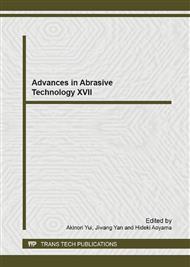[1]
Mariayyah, Ravishankar, John Patten, Relationship between machining forces and diamond tool wear during ductile regime machining of silicon nitride, Machining Science and Technology. 2012, 16(1): 53-70.
DOI: 10.1080/10910344.2012.648556
Google Scholar
[2]
Yang Junde, Luo Zhongping, Lu Fan, Mechanical analysis of diamond saw blade, Key Engineering Materials. pp.539-545, (2011).
DOI: 10.4028/www.scientific.net/kem.480-481.539
Google Scholar
[3]
James Thomas, Domblesky Josephp, Study of blade wear in reciprocating sawing, ASME 2010 International Mechanical Engineering Congress and Exposition. (IMECE 2010), pp.969-975.
DOI: 10.1115/imece2010-38819
Google Scholar
[4]
Vogt B, Ultrasonic technology revolutionists the machining of brittle-hard materials. Industrial Diamond Review. pp.242-245, (2002).
Google Scholar
[5]
Yang Yang, Lin Bin. Situations and development trends of ultrasonic machining tool and ultrasonic machining technology, Applied Mechanics and Materials, (37) pp.1199-1205, (2010).
DOI: 10.4028/www.scientific.net/amm.37-38.1199
Google Scholar
[6]
Sun Yazhou, Zhang Jing, Liu Haitao, Experimental research on ultrasonic torsional vibration-assisted grinding of hard and brittle materials, Key Engineering Materials. pp.101-104, (2014).
DOI: 10.4028/www.scientific.net/kem.579-580.101
Google Scholar
[7]
Berend Denkena, Luis de Leon, Dennis Hahmann, Ultrasonic assisted grinding of brittle materials - Surface topography and process forces, Proceedings of ASPE (2008).
Google Scholar
[8]
Dong Guojun, Zhou Ming, Huang Shaonan, Study on the surface quality of silicon nitride ceramics in ultrasonic vibration grinding, Key Engineering Materials, pp.144-147, (2014).
DOI: 10.4028/www.scientific.net/kem.579-580.144
Google Scholar
[9]
Mult H C, Spur G, Holl S E, Ultrasonic Assisted Grinding of Ceramics. Journal of materials processing technology, 62(1996), pp.287-293.
DOI: 10.1016/s0924-0136(96)02422-3
Google Scholar
[10]
Karakurt Izzet, Aydin Gokhan, Aydiner Kerim, An experimental study on the cutting force of circular diamond saw blades in stone sawing. SGEM 2012, pp.433-440.
DOI: 10.5593/sgem2012/s03.v1004
Google Scholar
[11]
Yan Peng, Zhang Jianhua, Su Guosheng, Grinding force of ultrasonic vibration assisted grinding combined with EDM, Advanced Materials Research, pp.287-294, (2012).
DOI: 10.4028/www.scientific.net/amr.500.287
Google Scholar
[12]
Zhang Hongli, Zhang Jianhua, Study on the cutting deforming force of single abrasive grit for ultrasonic vibration assisted grinding along normal direction, Advanced Materials Research. pp.615-619, (2010).
DOI: 10.4028/www.scientific.net/amr.102-104.615
Google Scholar


